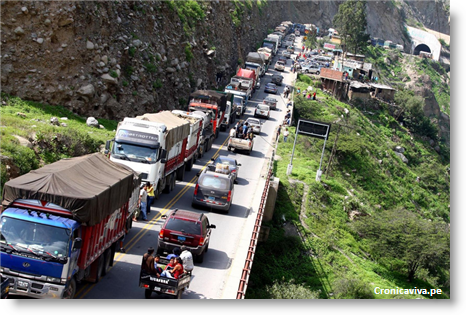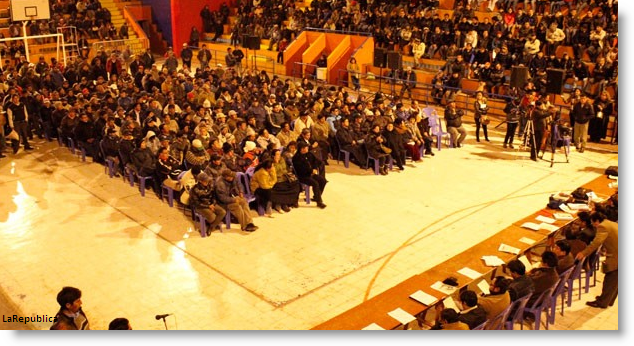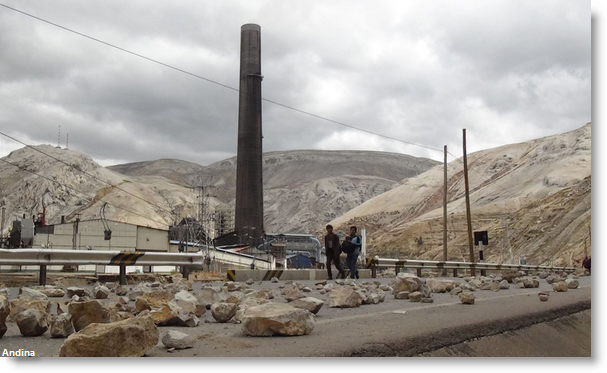 One person has died and four seriously wounded since workers in La Oroya began blocking the central highway early Tuesday, using tires, rocks and tree trunks along 10 km of the road.
One person has died and four seriously wounded since workers in La Oroya began blocking the central highway early Tuesday, using tires, rocks and tree trunks along 10 km of the road.
Police chief Gen. Jorge Flores said that the front line of police are armed with non-lethal weapons, and that the police have identified several people among the protestors who are armed. “We cannot permit that a road that is so important to the Republic be blocked, and the police will act according to protocols and the law.”
The protesters are demanding that the regional government of Junin act as an intermediary in the sale of the La Oroya refinery complex, which would be scheduled to go into liquidation because the government has been unsuccessful in attracting bidders.
The townspeople and 2,400 smelter workers fear a collective lay-off and an impending liquidation of Doe Run’s assets in Peru, which include the Metallurgical Complex of La Oroya and the Cobriza mine.
 At a town hall meeting held in the sports coliseum in Yali on Monday night, regional president Angel Unchupaico called for “calm, and to work towards dialogue to find a solution to this very delicate social problem, but we cannot take forceful measures.”
At a town hall meeting held in the sports coliseum in Yali on Monday night, regional president Angel Unchupaico called for “calm, and to work towards dialogue to find a solution to this very delicate social problem, but we cannot take forceful measures.”
Unchupaico said the blockade would cause serious financial harm to the five regions connected by the highway.
The Carretera Central is the main connection between Lima and not only the commercial hub of Huancayo and other central Andean towns but also the central jungle as well as parts of the Huancavelica and Ayacucho regions.
Several district mayors and two members of Congress for Junin were at the meeting, and Unchupaico and the congressmen traveled to Lima immediately after the meeting to request that Premier Pedro Cateriano install a technical negotiating team.
The townspeople and workers of the La Oroya smelters are demanding that the government be more flexible in its environmental standards, that an emergency decree be issued to protect the 2,400 jobs, and that the sale negotiators — UBS and Profit Consultoría— be changed. The previous administrating company, Business Right, was rejected by the employees in August last year, when the creditors decided to stop restructuring the company and focus on its liquidation.
 Last week, on August 6, there were no bidders at the auction of the Metallurgical Complex, despite an initial interest and due diligence by nine companies late last year. The schedule set by the creditors was that if the sale was unsuccessful, the company will go into liquidation on August 27.
Last week, on August 6, there were no bidders at the auction of the Metallurgical Complex, despite an initial interest and due diligence by nine companies late last year. The schedule set by the creditors was that if the sale was unsuccessful, the company will go into liquidation on August 27.
Profit Consultoría stated that the absence of bidders was due to the rigidity of the environmental regulations recently approved by the government.
According to Luis Castillo, representative of the worker creditors, potential bidders had noted that meeting the annual and daily air quality standards would be financially difficult.
The complex — built by the Cerro de Pasco Corporation in 1922 (copper) and 1928 (lead), transformed polymetallic ores for several mining companies into metals that include copper, zinc, silver, lead, gold, selenium and several by-products. It was nationalized in 1971 during the military government led by Gen. Juan Velasco.
Doe Run acquired the complex and the Cobriza mine in a privatization process in 1997 and was faced with a challenging pollution problem that it reduced measurably over the next several years. However, pollution remained serious — by 2007, it still ranked among the world’s worst polluted places— and attempts to move the population further from the refinery were unsuccessful. In 2009, when Doe Run decided to remove its personnel, the company owed Peru $163 million. Since then, La Oroya has been in the hands of administrators chosen by the creditors.






The people protesting about the liquidation of the mining operation and smelter at the Doe Run site, are wasting their time. The time to have saved the operation was in the 1990s. The billionaire man that operated the complex at that time did not renovate the smelter. He made about 450 million dollars in profits at that time, but the government at the time was not able to enforce their agreement, to modernize the smelter. Prices were high at that time for the metals produced there, but now metal prices are collapsing globally. I doubt the government could find a buyer for this smelter, even if the government cancelled all environment pollution laws, and any taxes to be paid by the operation. Maybe in 5 or 10 years when metal prices recover, the government might find a company willing to invest in the smelter and mining operation.
The only thing the government can do now, is to give assistance to the workers at the smelter, to relocate to another city in Peru. As polluted as this place is, it would be the best thing they could do, for the future of their children.